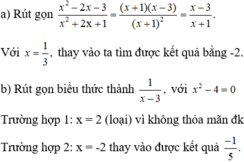

Hãy nhập câu hỏi của bạn vào đây, nếu là tài khoản VIP, bạn sẽ được ưu tiên trả lời.



1, \(=\left[\frac{\left(1-x\right)\left(1+x+x^2\right)}{1-x}-x\right]:\frac{1-x^2}{\left(1-x\right)-x^2\left(1-x\right)}\)
\(=\left(1+x+x^2-x\right):\frac{1-x^2}{\left(1-x\right)\left(1-x^2\right)}\)\(=\left(x^2+1\right)\left(1-x\right)\)
2, để B<0 <=> (x2+1)(1-x)<0
vì x^2+1 > 0 với mọi x
=> \(\hept{\begin{cases}x^2+1>0\\1-x< 0\end{cases}\Leftrightarrow x>1}\)
3, \(\left|x-4\right|=5\Leftrightarrow\orbr{\begin{cases}x=9\\x=-1\left(loại\right)\end{cases}}\)
Thay x=9 vào B ta có: B=(92+1)(1-9)=82.(-8)=-656

a, Ta có : \(\dfrac{98x^2-2}{x-2}=0\Leftrightarrow\left\{{}\begin{matrix}98x^2-2=0\\x-2\ne0\end{matrix}\right.\)
hay \(\left\{{}\begin{matrix}x^2=\dfrac{1}{49}\\x\ne2\end{matrix}\right.\Leftrightarrow x=\pm\dfrac{1}{7}\)
Vậy giá trị của phân thức này bằng 0 khi \(x=\pm\dfrac{1}{7}\)
b, Ta có : \(\dfrac{3x-2}{x^2+2x+1}=0\Leftrightarrow\dfrac{3x-2}{\left(x+1\right)^2}=0\Leftrightarrow\left\{{}\begin{matrix}3x-2=0\\\left(x+1\right)^2\ne0\end{matrix}\right.\)
hay \(\left\{{}\begin{matrix}x=\dfrac{2}{3}\\x\ne-1\end{matrix}\right.\)
Vậy giá trị của phân thức này bằng 0 khi \(x=\dfrac{2}{3}\)
a)
98x^2 -2 =0 =>x^2 =1/49 => x= -+1/7 nhận
b)
3x-2=0=>x=2/3 nhận

bài1 A=\(\left(\frac{3-x}{x+3}\cdot\frac{x^2+6x+9}{x^2-9}+\frac{x}{x+3}\right):\frac{3x^2}{x+3}\)
=\(\left(-\frac{x-3\cdot\left(x+3\right)^2}{\left(x+3\right)^2\cdot\left(x-3\right)}+\frac{x}{x+3}\right):\frac{3x^2}{x+3}\)
=\(-\frac{x}{x+3}\cdot\frac{x+3}{3x^2}=\frac{-1}{3x}\)
b) thế \(x=-\frac{1}{2}\)vào biểu thức A
\(-\frac{1}{3\cdot\left(-\frac{1}{2}\right)}=\frac{2}{3}\)
c) A=\(-\frac{1}{3x}< 0\)
VÌ (-1) <0 nên 3x>0
x >0

a)\(\left(\frac{1-x^3+1-x-x}{1-x}\right):\frac{-\left(x-1\right)\left(x+1\right)}{\left(x+1\right)\left(x-1\right)^2}=\left(\frac{-x^3-2x+2}{1-x}\right)\cdot\left(1-x\right)=-x^3-2x+2\)
b) \(-\left(-1\frac{2}{3}\right)-2\cdot\left(-1\frac{2}{3}\right)+2=\frac{5}{3}+\frac{10}{3}+2=7\)

a,\(A=\frac{6x+12}{\left(x+2\right)\left(2x-6\right)}=\frac{6\left(x+2\right)}{2\left(x+2\right)\left(x-3\right)}=\frac{3}{x-3}\)
b, Giá trị của x để phân thức có giá trị bằng (-2) :
\(\frac{3}{x-3}=-2\Rightarrow x=1,5\)

a) \(P=\dfrac{2x-4}{x^2-4x+4}-\dfrac{1}{x-2}=\dfrac{2\left(x-2\right)}{\left(x-2\right)^2}-\dfrac{1}{x-2}\)
\(=\dfrac{2x-4-\left(x-2\right)}{\left(x-2\right)^2}=\dfrac{x-2}{\left(x-2\right)^2}=\dfrac{1}{x-2}\)
ĐKXĐ: \(x\ne2\) nên với x = 2 thì P không được xác định
\(Q=\dfrac{3x+15}{x^2-9}+\dfrac{1}{x+3}-\dfrac{2}{x-3}\)
\(=\dfrac{3\left(x+5\right)}{\left(x-3\right)\left(x+3\right)}+\dfrac{1}{x+3}-\dfrac{2}{x-3}\)
\(=\dfrac{3x+15+x-3-2\left(x+3\right)}{x^2-9}=\dfrac{2x+6}{x^2-9}=\dfrac{2\left(x+3\right)}{\left(x+3\right)\left(x-3\right)}=\dfrac{2}{x-3}\)
Tại x = 2 thì \(Q=\dfrac{2}{2-3}=\dfrac{2}{-1}=-2\)
b) Để P < 0 tức \(\dfrac{1}{x-2}< 0\) mà tứ là 1 > 0
nên để P < 0 thì x - 2 < 0 \(\Leftrightarrow x< 2\)
Vậy x < 2 thì P < 0
c) Để Q nguyên tức \(\dfrac{2}{x-3}\) phải nguyên
mà \(\dfrac{2}{x-3}\) nguyên khi x - 3 \(\inƯ_{\left(2\right)}\)
hay x - 3 \(\in\left\{-2;-1;1;2\right\}\)
Lập bảng :
x - 3 -1 -2 1 2
x 2 1 4 5
Vậy x = \(\left\{1;2;4;5\right\}\) thì Q đạt giá trị nguyên
a) \(\dfrac{20x^3}{11y^2}.\dfrac{55y^5}{15x}=\dfrac{20.5.11.x.x^2.y^2.y^3}{11.3.5.x.y^2}=\dfrac{20x^2y^3}{3}\)
b) \(\dfrac{5x-2}{2xy}-\dfrac{7x-4}{2xy}=\dfrac{5x-2-7x+4}{2xy}=\dfrac{-2x+2}{2xy}=\dfrac{2\left(1-x\right)}{2xy}=\dfrac{1-x}{xy}\)

\(A=\left(x-4\right)^2-\left(x+4\right)^2-16\left(x-2\right)\)
\(=x^2-8x+16-x^2-8x-16-16x+32\)
\(=-32x+32\)
Biểu thức phụ thuộc vào giá trị của biến

câu 1
a)\(ĐKXĐ:x^3-8\ne0=>x\ne2\)
b)\(\frac{3x^2+6x+12}{x^3-8}=\frac{3\left(x^2-2x+4\right)}{\left(x-2\right)\left(x^2-2x+4\right)}=\frac{3}{x-2}\left(#\right)\)
Thay \(x=\frac{4001}{2000}\)zô \(\left(#\right)\)ta được
\(\frac{3}{\frac{4001}{2000}-2}=\frac{3}{\frac{4001}{2000}-\frac{4000}{2000}}=\frac{3}{\frac{1}{2000}}=6000\)